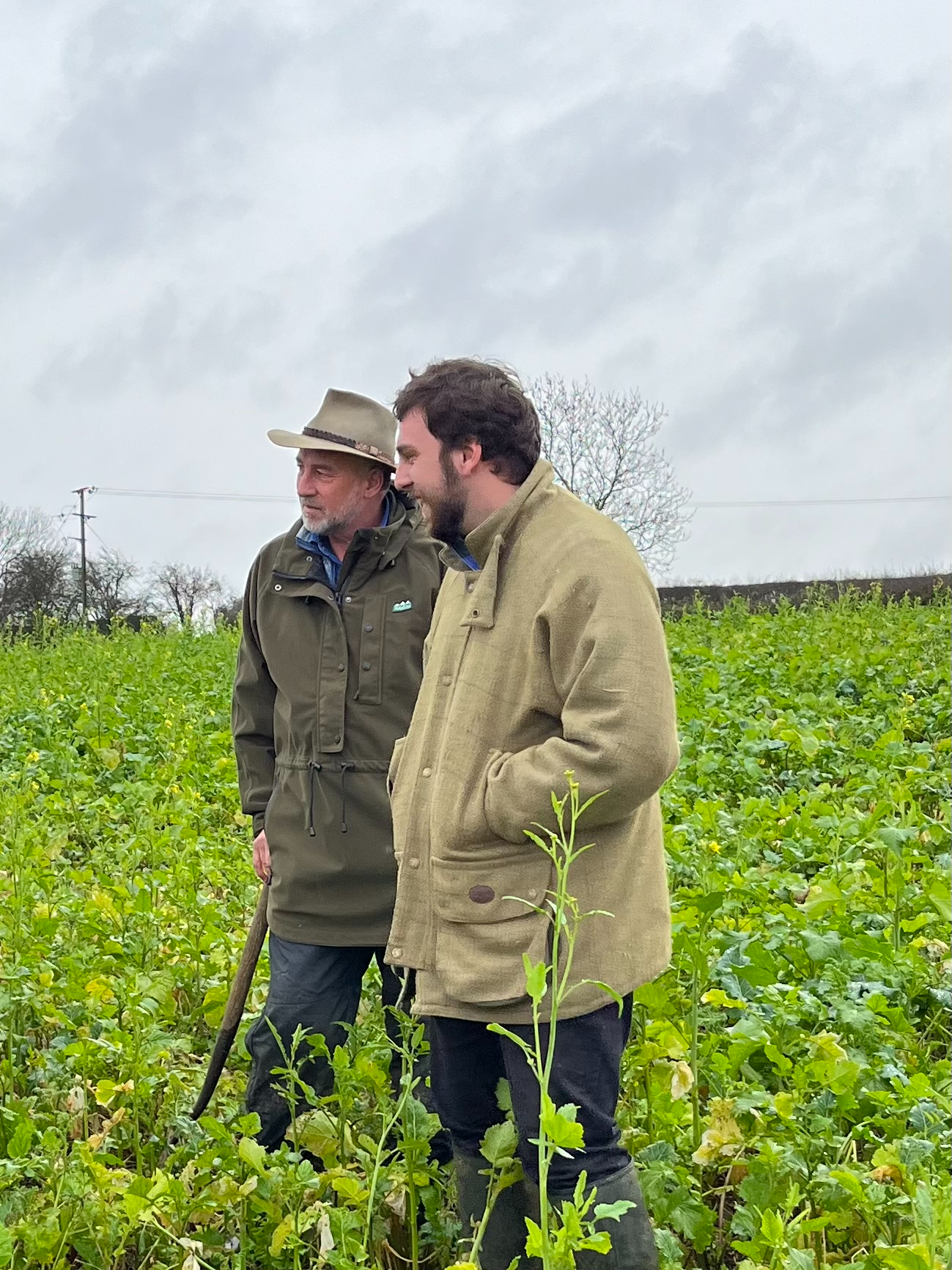BASE-UK - FARM WALK REVIEW - CHRIS AND WIL MORRIS, PADBURY, BUCKS
Posted December, 19th, 2023
WIL AND CHRIS MORRIS - FARM WALK REVIEW
Wil and Chris Morris invited BASE-UK members to a walk on their farm in December 2023. BASE-UK member Louise Impey has written the following review of the event.
Chris and Wil Morris (picture right)
The integral role of cover crops in the Morris family’s mixed farming system in Buckinghamshire was the talking point on a recent farm walk for BASE-UK members.
Both summer and over-winter cover crops are grown at Grange Farm in Padbury, with the former used where spring cropping has failed and the latter focussed on providing sheep grazing and keeping soils in good condition. Having been direct drilling for the last five years on heavy land that can be adversely affected by the weather and is prone to black-grass, Chris and Wil Morris keep the rotation as flexible as possible.
Winter wheat, spring wheat and spring oats are the main cash crops. The lack of profit in break crops means that oilseed rape has been dropped, making cover crops an essential part of their system for adding plant diversity and de-risking the business.
Their cover crop commitment is also keeping costs down. Nutrient cycling, weed suppression and improved soil function have helped to reduce their reliance on inputs, while supplementary feeding of the sheep is minimal.
Low-cost establishment methods are preferred when it comes to the cover crops, explains Wil Morris, with Autocasting used behind the combine for most of the winter cover crops, followed by a rake and roll operation.
“That costs us £21/ha,” he says. “The seed is around £20/ha for a six species mix of crimson and berseem clover, phacelia, brown mustard, forage rape and stubble turnips, which we drill at a seed rate of 6.5kg/ha.”

If 40kg/ha of fertiliser is placed with the seed, the cost rises to £68.40/ha, he adds.
The stubble turnips are 25% of the mix, being an important component for winter grazing by their sheep flock.
The covers are destroyed by both grazing and subsequent spraying, before being drilled with the chosen spring crop.
Summer cover crops were grown for the first time in 2023, after the decision was taken to ‘pull the plug’ on some spring cropping. Two different mixes were compared – 8 species and 16 species – with the 8 species mix having two different drilling dates.
16 species mix
- Crimson clover 4%, dwarf sorghum 7%, buckwheat 7.5%, vetch 20%, sunflowers 8%, Rozetta red clover 2.5%, Jap reed millet 2.5%, fodder radish 8%, white lupins 6.5%, linseed 7.5%, berseem clover 2.5%, forage peas 6.5%, forage rape 5%, phacelia 2.5% and white mustard 2.5%
- Drilled at 27kg/ha
- Seed cost £67.50/ha
8 species mix
- Amelia vetch 24.75%, berseem clover 9%, crimson clover 4.5%, Rozetta red clover 2.25%, structurator tillage radish 9%, fodder radish 15%, sunflowers 7%, linseed 28.5%
- Drilled at 17kg/ha
- Seed cost £44.20/ha
Wil’s September-timed measurements show that the 16-way mix had produced 55.4t/ha of fresh matter from a mid-June drilling date, containing 150kg/ha of N, 35kg/ha of P and 278kg/ha of K. That meant 2.9t/ha of carbon was captured and the potential saving in fertiliser was £388.02.
The 8-way mix produced 80.6t/ha of fresh matter from the same drilling date, capturing more nutrients and 7.8t/ha of carbon, saving £770.56 in fertiliser.
Delaying the drilling date by a month, until July 20, saw the cover crop capture about half of the nutrients and carbon from the earlier date, representing a £365.70 fertiliser saving.
“That’s been one of our learnings,” says Wil. “An extra month of harvesting sunlight made a huge difference to the results.”
No assumptions were made on what nutrition would be available to the following crop, but the concept of summer cover crops has shown to be a good one for the farm. As they are in the SFI Pilot, the Morris’s hope that summer cover crops will become an accepted SFI action as more scheme details are rolled out.
They were either rolled and then drilled into in the autumn, or were drilled into without any interference using the farm’s Sky drill. Glyphosate was added to the pre-emergence herbicide, to ensure the winter wheat could get away.
Elsewhere on the farm a three species clover understory, which has been in place for five years, doesn’t seem to be contributing much, he comments.
“It’s a good concept for a number of reasons but we don’t seem to be getting the nodulation that we expected, so it’s difficult to know what benefit they are bringing.”
Thanks to Wil and Chris for opening up their farm and sharing their experience.
Wil recently attended a communication skills training day sponsored by BASE-UK and used his skills to confidently present at his farm walk.
Recent Posts
BASE-UK - ANNUAL CONFERENCE 2024 - SIX INCHES OF SOIL PREVIEW
BASE-UK - ANNUAL CONFERENCE 2024 DAY 2 - HANNAH FRASER
BASE-UK - ANNUAL CONFERENCE 2024 DAY 2 - RICHARD JENNER
BASE-UK - ANNUAL CONFERENCE 2024 DAY 2 - DAVID GOODWIN
BASE-UK - ANNUAL CONFERENCE - DAY 2 - JAY FUHRER PART 2
BASE-UK - ANNUAL CONFERENCE DAY 2 - JAY FUHRER PART 1
BASE-UK - ANNUAL CONFERENCE DAY 1 - SPEAKER PANEL
BASE-UK - ANNUAL CONFERENCE DAY 1 - BEN ADAMS
BASE-UK - ANNUAL CONFERENCE DAY 1 - TOBY SIMPSON
BASE-UK - ANNUAL CONFERENCE DAY 1 - ALEX FRASER
